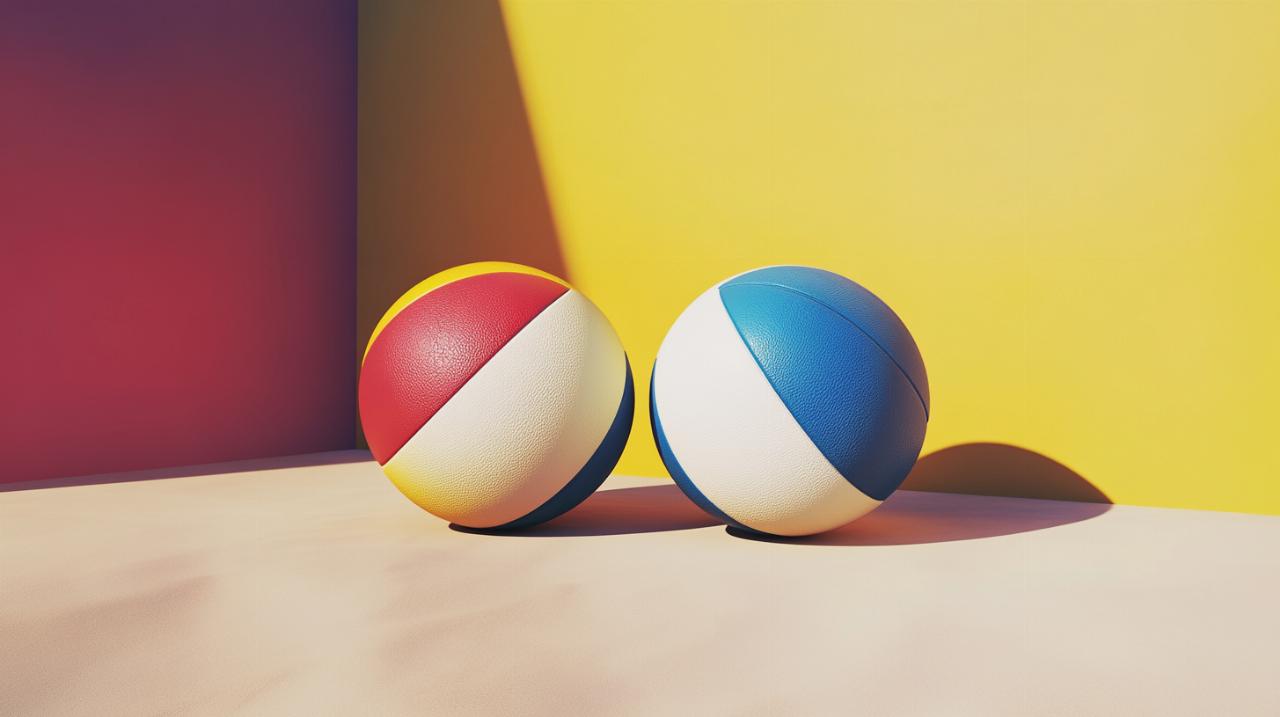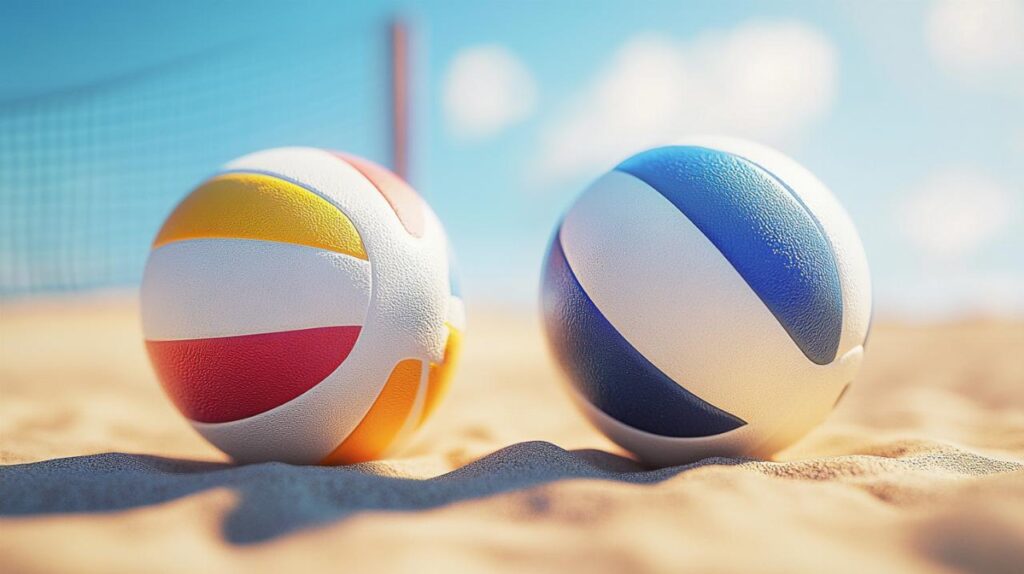Selecting the right volleyball can transform your game, whether you're diving for saves on sun-drenched sands or executing precise spikes in a climate-controlled sports hall. The decision between beach and indoor volleyballs isn't simply a matter of preference; it involves understanding how each ball is engineered for its specific environment. From material composition to weight distribution, every element is tailored to enhance performance and durability where it matters most. As you explore the nuances of each type, you'll discover that the perfect volleyball is one that complements your playing style, environment, and ambitions on the court or shoreline.
Understanding the Key Differences Between Beach and Indoor Volleyballs
When you first hold a beach volleyball and then an indoor volleyball, the differences become immediately apparent. These variations aren't arbitrary; they're carefully calculated to match the demands of each playing environment. Beach volleyball and indoor volleyball may share fundamental rules, but the equipment used in each discipline has evolved along distinct paths to optimise performance. Understanding these differences is essential before making your purchase, and if you're keen to explore more detailed comparisons and recommendations, you should visit shopconnect blog for comprehensive guidance on volleyball equipment selection.
Size and weight variations: what makes each ball unique
Beach volleyballs tend to be slightly larger in circumference than their indoor counterparts, a design choice that serves multiple purposes. The increased surface area makes the ball more visible against the bright sky and sand, whilst also slowing its trajectory through outdoor air currents. Typically, a beach volleyball measures around sixty-six to sixty-eight centimetres in circumference, whilst indoor volleyballs hover closer to sixty-five to sixty-seven centimetres. This seemingly modest difference significantly affects how the ball behaves during play. The weight distribution also varies between the two types, with beach volleyballs often feeling lighter due to their softer construction, even though official regulations keep them within similar weight ranges. This lighter sensation helps players generate power without excessive force, crucial when your footing is compromised by shifting sand. Indoor volleyballs, conversely, are constructed to maintain consistent weight throughout rapid exchanges, allowing for predictable rebounds off gymnasium floors and enabling the lightning-fast rallies that characterise competitive indoor matches.
Material composition: soft touch vs firm grip
The material composition of these volleyballs reveals perhaps the most pronounced distinction between the two varieties. Beach volleyballs feature a softer, more pliable outer shell that cushions impact and reduces the sting when making contact with bare skin, particularly important given that beach players often wear less protective gear than their indoor counterparts. This softer touch also accommodates the lower and longer contact that characterises beach volleyball setting techniques, where double contacts are judged more strictly than in indoor play. The outer surface of beach volleyballs typically incorporates a coating designed to repel water and prevent the ball from becoming waterlogged during seaside matches, maintaining consistent performance even when splashed by waves or dampened by coastal humidity. Indoor volleyballs, by contrast, employ firmer materials that provide a more responsive grip on gymnasium surfaces. The tighter construction allows for greater speed and more precise control during fast-paced indoor rallies, where players execute standardised setting techniques and variable offensive strategies. Modern indoor volleyball designs often utilise thermal-bonded reinforcements and advanced synthetic leathers that maintain their shape and responsiveness throughout countless impacts against hardwood floors, ensuring the ball behaves predictably during those crucial moments when matches are decided by millimetres and milliseconds.
Choosing the Right Volleyball for Your Playing Environment

Once you understand the technical differences between beach and indoor volleyballs, the next step involves matching those characteristics to your specific playing conditions. The environment where you'll spend most of your time dictates which features matter most. A ball optimised for one setting may perform poorly in another, so thoughtful selection ensures you're not fighting against your equipment when you should be focusing on technique and strategy.
Beach volleyball features: water-resistance and outdoor durability
Beach volleyballs are engineered to withstand the unique challenges of outdoor play, where exposure to moisture, sand, and intense sunlight can quickly degrade inferior equipment. The water-resistant coating applied to quality beach volleyballs serves a dual purpose: preventing water absorption that would increase weight and alter flight characteristics, whilst also protecting the underlying materials from UV degradation that causes fading and brittleness. This coating must be robust enough to endure repeated contact with abrasive sand particles without wearing away, yet flexible enough to maintain the ball's soft touch that makes beach volleyball distinctive. The construction often incorporates drainage features that allow any moisture that does penetrate the outer layers to escape, preventing the accumulation of water within the ball's structure. Durability in beach volleyballs extends beyond water resistance to encompass resilience against temperature extremes, as sand surfaces can reach scorching temperatures exceeding sixty degrees Celsius on sunny days. Quality beach volleyballs maintain their shape and performance characteristics across this temperature range, ensuring consistent play whether you're enjoying a morning match in cooler conditions or competing during the midday heat. The stitching and panel construction in beach volleyballs also differs from indoor models, with reinforced seams that resist the constant abrasion of sand particles and the stress of outdoor play.
Indoor volleyball characteristics: speed and court performance
Indoor volleyballs are precision instruments designed for the controlled environment of sports halls, where consistent temperature, humidity, and playing surfaces allow for optimised performance characteristics. The firmer construction of indoor volleyballs facilitates the rapid exchanges and powerful spikes that define competitive indoor play, with the ball rebounding predictably off gymnasium floors and maintaining its trajectory with minimal air resistance. This firmness also enhances the ball's responsiveness to subtle hand movements, crucial for setters who must place the ball with centimetre precision to create scoring opportunities. The grip pattern on indoor volleyballs is engineered to complement the smooth hardwood surfaces found in most gymnasiums, providing just enough texture for players to impart spin and control without requiring the aggressive grip needed for softer beach balls. Modern indoor volleyballs often feature advanced midsole technology adapted from athletic footwear design principles, with layered construction that balances responsiveness with durability. These balls are built to withstand the intense forces generated during indoor play, where powerful serves and spikes can exceed one hundred kilometres per hour. The synthetic materials used in quality indoor volleyballs resist the gradual loss of air pressure that plagues inferior models, maintaining optimal inflation across extended training sessions and competitive matches. Colour schemes for indoor volleyballs typically favour high-contrast panels that remain visible under artificial lighting, with designs that help players quickly assess ball rotation and trajectory during split-second decision-making moments.


